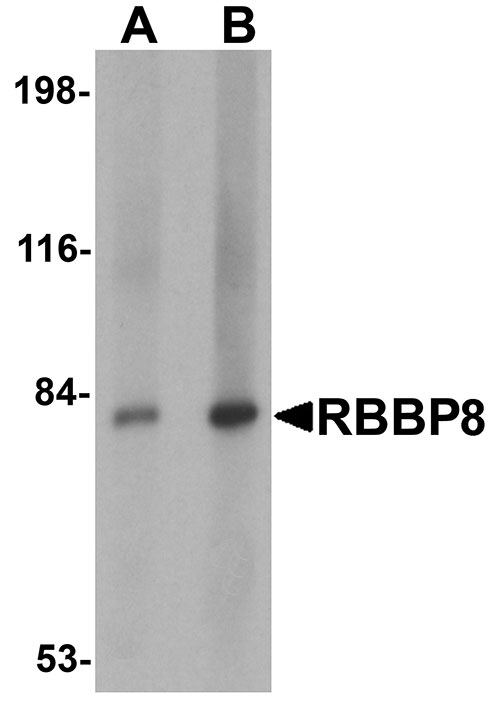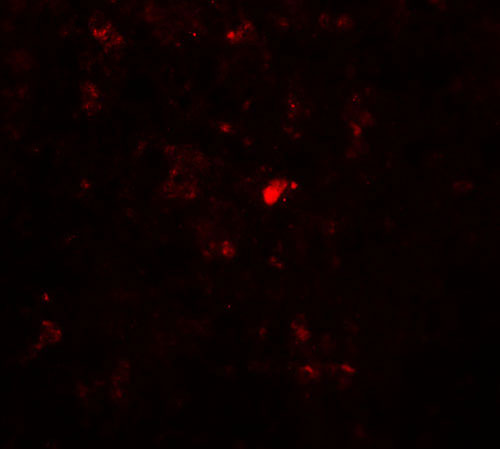RBBP8 Antibody
- 产品详情
- 实验流程
- 背景知识
Application
| WB, IF, E, IHC-P |
|---|---|
| Primary Accession | Q99708 |
| Other Accession | NP_976037, 42718017 |
| Reactivity | Human, Mouse, Rat |
| Host | Rabbit |
| Clonality | Polyclonal |
| Isotype | IgG |
| Calculated MW | 101942 Da |
| Concentration (mg/ml) | 1 mg/mL |
| Conjugate | Unconjugated |
| Application Notes | RBBP8 antibody can be used for detection of RBBP8 by Western blot at 1 - 2 µg/mL. Antibody can also be used for immunohistochemistry starting at 5 µg/mL. For immunofluorescence start at 20 µg/mL. |
| Gene ID | 5932 |
|---|---|
| Other Names | DNA endonuclease RBBP8, 3.1.-.-, CtBP-interacting protein, CtIP, Retinoblastoma-binding protein 8, RBBP-8, Retinoblastoma-interacting protein and myosin-like, RIM, Sporulation in the absence of SPO11 protein 2 homolog, SAE2, RBBP8, CTIP |
| Target/Specificity | RBBP8; |
| Reconstitution & Storage | RBBP8 antibody can be stored at 4℃ for three months and -20℃, stable for up to one year. As with all antibodies care should be taken to avoid repeated freeze thaw cycles. Antibodies should not be exposed to prolonged high temperatures. |
| Precautions | RBBP8 Antibody is for research use only and not for use in diagnostic or therapeutic procedures. |
| Name | RBBP8 |
|---|---|
| Synonyms | CTIP |
| Function | Endonuclease that cooperates with the MRE11-RAD50-NBN (MRN) complex in DNA-end resection, the first step of double-strand break (DSB) repair through the homologous recombination (HR) pathway (PubMed:17965729, PubMed:19202191, PubMed:19759395, PubMed:20064462, PubMed:23273981, PubMed:26721387, PubMed:27814491, PubMed:27889449, PubMed:30787182). HR is restricted to S and G2 phases of the cell cycle and preferentially repairs DSBs resulting from replication fork collapse (PubMed:17965729, PubMed:19202191, PubMed:23273981, PubMed:27814491, PubMed:27889449, PubMed:30787182). Key determinant of DSB repair pathway choice, as it commits cells to HR by preventing classical non-homologous end-joining (NHEJ) (PubMed:19202191). Specifically promotes the endonuclease activity of the MRN complex to clear DNA ends containing protein adducts: recruited to DSBs by NBN following phosphorylation by CDK1, and promotes the endonuclease activity of MRE11 to clear protein-DNA adducts and generate clean double-strand break ends (PubMed:27814491, PubMed:27889449, PubMed:30787182, PubMed:33836577). Functions downstream of the MRN complex and ATM, promotes ATR activation and its recruitment to DSBs in the S/G2 phase facilitating the generation of ssDNA (PubMed:16581787, PubMed:17965729, PubMed:19759395, PubMed:20064462). Component of the BRCA1-RBBP8 complex that regulates CHEK1 activation and controls cell cycle G2/M checkpoints on DNA damage (PubMed:15485915, PubMed:16818604). During immunoglobulin heavy chain class-switch recombination, promotes microhomology-mediated alternative end joining (A-NHEJ) and plays an essential role in chromosomal translocations (By similarity). Binds preferentially to DNA Y-junctions and to DNA substrates with blocked ends and promotes intermolecular DNA bridging (PubMed:30601117). |
| Cellular Location | Nucleus. Chromosome Note=Associates with sites of DNA damage in S/G2 phase (PubMed:10764811, PubMed:25349192). Recruited to DSBs by the MRE11- RAD50-NBN (MRN) complex following phosphorylation by CDK1, which promotes interaction with NBN (PubMed:27814491, PubMed:27889449, PubMed:33836577). Ubiquitinated RBBP8 binds to chromatin following DNA damage (PubMed:16818604). |
| Tissue Location | Expressed in ER-positive breast cancer lines, but tends to be down-regulated ER-negative cells (at protein level) |
For Research Use Only. Not For Use In Diagnostic Procedures.
Provided below are standard protocols that you may find useful for product applications.
BACKGROUND
RBBP8 Antibody: RBBP8, also known as CtBP (carboxy-terminal binding protein) interacting protein (CTIP), was characterized for its role in transcription as a cofactor for the transcriptional repressor CtBP, and also as a binding partner for other proteins including the cell cycle regulators retinoblastoma protein (Rb) and breast cancer 1 (BRCA1). It is ubiquitously expressed and localizes to the nucleus. RBBP8 is thought to modulate the functions in cell proliferation, transcriptional regulation and DNA repair. RBBP8 also plays a central role in the cell cycle checkpoint response to DNA double-stranded breaks (DSBs), with new evidence demonstrating that it controls the choice of DSB repair pathway.
REFERENCES
Yu X, Wu LC, Bowcock AM, et al. The C-terminal (BRCT) domains of BRCA1 interact in vivo with CtIP, a protein implicated in the CtBP pathway of transcriptional repression. J. Biol. Chem.1998; 273:25388-92.
Liu F and Lee WH. CtIP activates its own and cyclin D1 promoters via the E2F/RB pathway during G1/S progression. Mol. Cell Biol.2006; 26:3124-34.
Sterner JM, Dew-Knight S, Musahl C, et al. Negative regulation of DNA replication by the retinoblastoma protein is mediated by its association with MCM7. Mol. Cell Biol.1998; 18:2748-57.
Wu G and Lee WH. CtIP, a multivalent adaptor connecting transcriptional regulation, checkpoint control and tumor suppression. Cell Cycle2006; 5:1592-6.
终于等到您。ABCEPTA(百远生物)抗体产品。
点击下方“我要评价 ”按钮提交您的反馈信息,您的反馈和评价是我们最宝贵的财富之一,
我们将在1-3个工作日内处理您的反馈信息。
如有疑问,联系:0512-88856768 tech-china@abcepta.com.























 癌症的基本特征包括细胞增殖、血管生成、迁移、凋亡逃避机制和细胞永生等。找到癌症发生过程中这些通路的关键标记物和对应的抗体用于检测至关重要。
癌症的基本特征包括细胞增殖、血管生成、迁移、凋亡逃避机制和细胞永生等。找到癌症发生过程中这些通路的关键标记物和对应的抗体用于检测至关重要。 为您推荐一个泛素化位点预测神器——泛素化分析工具,可以为您的蛋白的泛素化位点作出预测和评分。
为您推荐一个泛素化位点预测神器——泛素化分析工具,可以为您的蛋白的泛素化位点作出预测和评分。 细胞自噬受体图形绘图工具为你的蛋白的细胞受体结合位点作出预测和评分,识别结合到自噬通路中的蛋白是非常重要的,便于让我们理解自噬在正常生理、病理过程中的作用,如发育、细胞分化、神经退化性疾病、压力条件下、感染和癌症。
细胞自噬受体图形绘图工具为你的蛋白的细胞受体结合位点作出预测和评分,识别结合到自噬通路中的蛋白是非常重要的,便于让我们理解自噬在正常生理、病理过程中的作用,如发育、细胞分化、神经退化性疾病、压力条件下、感染和癌症。








